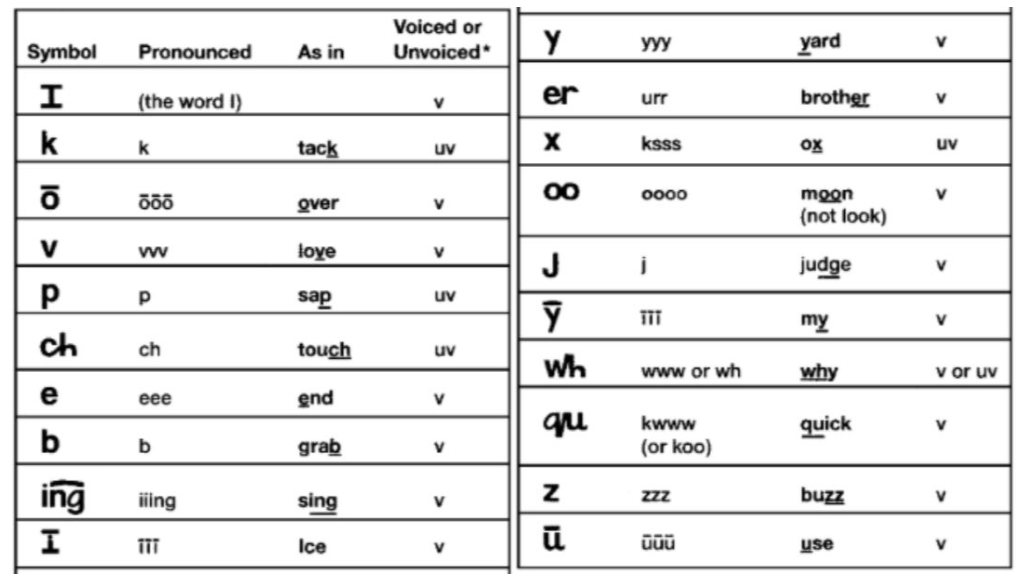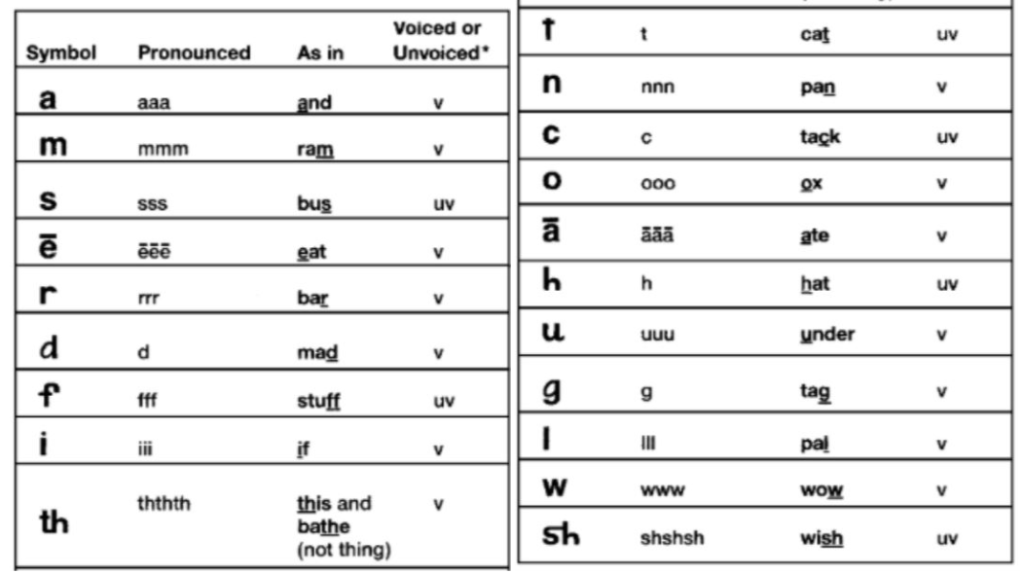Back to Course
Teach Reading Mastery Signature Edition: Year 1
0% Complete
0/0 Steps
-
Module Introduction4 Topics
-
Overview24 Topics|2 Tests
-
Cover
-
Lesson Objective
-
Opening the Lesson
-
Professional Learning Standards, Techniques and Practices
-
Direct Instruction Overview
-
RMSE 1 Overview
-
RMSE 1 Materials
-
Time Requirements
-
Placement Testing
-
Placement Testing Procedure
-
Student Errors on RMSE 1 Placement Test
-
Video: RMSE 1 Placement Test
-
Check Your Understanding
-
Grouping, Seating, STAR, Transitions
-
Video: Effective Routines
-
Script Features
-
Expected Lesson Pacing
-
Teacher’s Role in Motivation
-
Video: Affirmations
-
Specific Positive Feedback
-
Scenario
-
Test Your Understanding
-
Review
-
Lesson Completed!
-
Cover
-
Teaching Sounds15 Topics|1 Test
-
Cover
-
Lesson Objective
-
Opening the Lesson
-
Professional Learning Standards, Techniques and Practices
-
Orthography
-
Transition to Regular Orthography
-
Continuous Sounds
-
Stop Sounds
-
Voiced and Unvoiced
-
Explicit Phonics
-
Discriminate Stop Sounds
-
Video: RMSE 1 Sound Chart
-
Test Your Understanding
-
Review
-
Lesson completed!
-
Cover
-
Sounds, Sound Combinations, Sound Out First, Hard Words27 Topics|2 Tests
-
Cover
-
Lesson Objective
-
Opening the Lesson
-
Professional Learning Standards, Techniques, and Practices
-
Block One Activities
-
Point–Touch Explained
-
Video: Point Touch Signal
-
Block One Sounds
-
Corrections for Sound Identification Errors
-
Sound Combinations
-
Scenario
-
Looping Signal Explained
-
Video: Looping Signal
-
Point–Touch–Slide Explained
-
Video: Point Touch Slide
-
Check Your Understanding
-
Sound-out First
-
Sound-out/Say Fast Errors
-
Video: Sound It Out First with Error Correction
-
Hard Words
-
Reading the Fast Way: Correction
-
Hard Words in Reader
-
Hard Words Firm-up Procedures
-
Video: RMSE K – Word Reading
-
Test Your Understanding
-
Review
-
Lesson Completed!
-
Cover
-
Sound Combinations, Irregular Words, Two Part Words20 Topics|2 Tests
-
Cover
-
Lesson Objective
-
Opening the Lesson
-
Professional Learning Standards, Techniques and Practices
-
Sound-Combination Format
-
Sound-Combination Format Corrections
-
Read the Fast Way Format
-
Reading the Fast Way Corrections
-
Video: Reading the Fast Way with Error Correction
-
Check Your Understanding
-
Last-part, First-part Format
-
Last-part, First-part Corrections
-
Scenario
-
Irregular Words
-
Video: Irregular Words with Error Correction
-
Two-part-word Format
-
Re-reading Vocabulary Words and Individuals Turns
-
Test Your Understanding
-
Review
-
Lesson Completed!
-
Cover
-
Story Reading for Block One23 Topics|2 Tests
-
Cover
-
Lesson Objective
-
Opening the Lesson
-
Professional Learning Standards, Techniques and Practices
-
Story Reading Set-up
-
Story Reading: First Reading
-
Corrections First Reading
-
Story Reading: Second Reading (Lessons 1–18)
-
Comprehension Question (Corrections A)
-
Comprehension Question (Correction B)
-
Check for Understanding
-
Story Reading (Lessons 19–80)
-
Picture Comprehension
-
Video: Story Reading with Error Correction and Questions
-
Scenario
-
Read the Items (Format One)
-
Video: Read the Items
-
Read the Items (Format Two)
-
Read the Items (Corrections A)
-
Read the Items (Corrections B)
-
Test Your Understanding
-
Review
-
Lesson Completed!
-
Cover
-
Letter Names, Final E Rule20 Topics|2 Tests
-
Cover
-
Lesson Objective
-
Opening the Lesson
-
Professional Learning Standards, Techniques and Practices
-
Block Two Activities
-
Letter Names: Vowels
-
Letter Names: Vowel Corrections
-
Reading Vocabulary (Block Two)
-
Long Vowel Rule Format
-
Long-vowel Rule (Corrections)
-
Scenario – Student Errors on Long Vowels
-
Check Your Understanding
-
Video: Long Vowel Rule with Corrections
-
Practice the Final ‘e’ Rule
-
Long-vowel and Short-vowel Words Formats
-
Video: Long Vowel and Short Vowel Words with Error Correction and Individual Turns
-
Script Success
-
Test Your Understanding
-
Review
-
Lesson Completed!
-
Cover
-
Sound Combinations, Long and Short Vowel Words, Two-part Words, Story Reading Block Two18 Topics|2 Tests
-
Cover
-
Lesson Objective
-
Opening the Lesson
-
Professional Learning Standards, Techniques and Practices
-
Disjoined Sound Combinations
-
Disjoined Sound Combinations Corrections
-
Long-vowel and Short-vowel Words
-
Long-vowel and Short-vowel Corrections
-
Video: Long and Short Vowel Words with Error Correction
-
Check Your Understanding
-
Two-part Words
-
Two-part Words (Corrections)
-
Scenario
-
Story Reading Progression (Block Two)
-
Repeat Until Firm
-
Test Your Understanding
-
Review
-
Lesson Completed!
-
Cover
-
Block Three Reading Vocabulary Exercises23 Topics|2 Tests
-
Cover
-
Lesson Objective
-
Opening the Lesson
-
Professional Learning Standards, Techniques and Practices
-
Block Three
-
Letter Names and Capital Letters
-
Reading Vocabulary (Block Three)
-
Correction Procedure (Lessons 81–90)
-
Spelling by Letter Names
-
Video: Spelling by Letter Names
-
Spell Then Read
-
Scenario
-
Check Your Understanding
-
Words in Red
-
Reading the Fast Way Correction
-
Video: Reading the Fast Way Error Correction
-
Video: Using Specific Positive Praise
-
Words with Underlined Parts
-
Underlined Part Corrections
-
Video: Words in Red with Error Correction
-
Test Your Understanding
-
Review
-
Lesson Completed!
-
Cover
-
Story Reading Block Three, RMSE 1 Kit Spelling20 Topics|2 Tests
-
Cover
-
Lesson Objective
-
Opening the Lesson
-
Professional Learning Standards, Techniques and Practices
-
Story Reading (Block Three)
-
Story Reading Format
-
‘The Rule’ Stories
-
Read-the-Items (Block Three)
-
Video: Story Reading to the Red 5
-
Check Your Understanding
-
RMSE 1 Kit Spelling Overview
-
Progression of Skills Taught
-
RMSE 1 Kit Spelling (General Procedures)
-
RMSE 1 Kit Spelling (Early Lesson)
-
RMSE 1 Kit Spelling (Work Check)
-
Scenario
-
Video: RMSE 1 Kit Spelling Lesson
-
Test Your Understanding
-
Review
-
Lesson Completed!
-
Cover
-
Independent Work, In-program Tests, Motivating Students26 Topics|2 Tests
-
Cover
-
Lesson Objective
-
Opening the Lesson
-
Professional Learning Standards, Techniques and Practices
-
Independent Work (Beginning Levels)
-
Video: Independent Work with Active Monitoring
-
Work Check (Beginning Levels)
-
Block One Worksheets
-
Block Two Worksheets
-
Block Three Worksheets
-
Fluency Checkouts
-
Video: RMSE 1 Fluency Checkout
-
Checkouts on SPT
-
Video: Inputting data on SPT
-
Check for Understanding
-
Engaging Students
-
The Teacher’s Role in Motivation
-
Video: Affirmations
-
Teacher–Student Game
-
Video: Teacher–Student Game
-
Game Guidelines
-
Specific Praise
-
Video: Using Specific Praise Throughout the Day
-
Test Your Understanding
-
Review
-
Lesson Completed!
-
Cover
-
Module evaluation survey1 Topic
Participants 551
Lesson Progress
0% Complete

Orthography
Orthography refers to the letters that make up words. Reading from traditional orthography can be confusing.
While some words are regular words, which can be easily sounded out, like the word ‘hat’, others are more difficult. The word ‘was’ is not spelled like it sounds; ‘woz’.
Using the RMSE 1 orthography means that more words are regular words.
- Sounds ‘th’, ‘ch’, ‘sh’, ‘wh’, ‘qu’, ‘er’, ‘oo’ and ‘ing’ are represented by joined letters.
- Macrons (lines over vowels) distinguish long vowels from short vowels.
- The appearance of ‘b’ and ‘d’, ‘n’ and ‘h’, ‘f’ and ‘t’, and ‘j’ and ‘i’ are changed to minimise confusion caused by their visual similarity.
- At the beginning of RMSE 1, all sounds except ‘I’ appear as lowercase letters.
Letters are referred to as sounds in RMSE 1.



